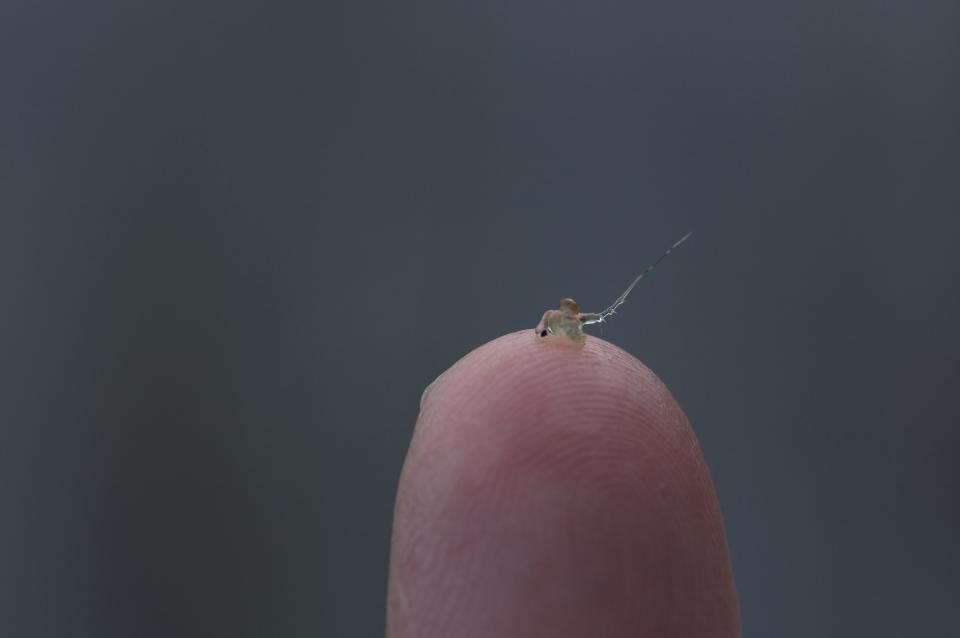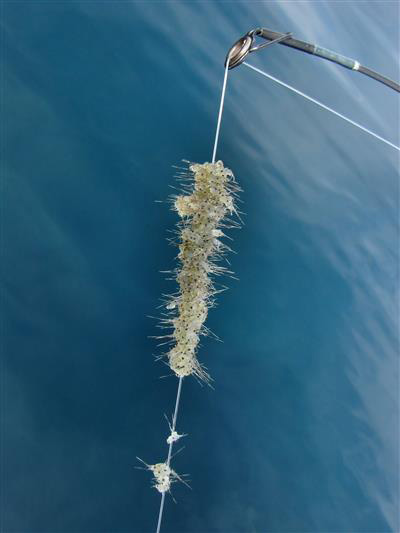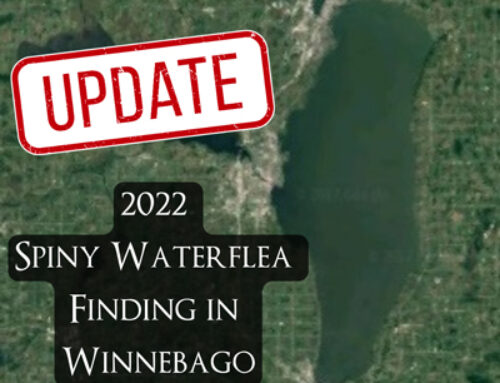Two Individuals Found in Summer 2022 Monitoring Efforts
 A newly verified finding of spiny waterflea (Bythotrephes longimanus) was discovered in Lake Winnebago in Summer 2022. This finding represents the first verification of this species in Lake Winnebago. Live adult spiny waterfleas were found in two sampling events on the Lake; conducted July 26th and August 22nd 2022 (one adult found during each event). The two live spiny waterfleas were found near the mouth of the Menasha Channel just south of Jefferson Park in Menasha. The waterfleas were discovered by UW Green Bay through the Fox River Navigational System Authority (FRNSA) AIS Monitoring Program.
A newly verified finding of spiny waterflea (Bythotrephes longimanus) was discovered in Lake Winnebago in Summer 2022. This finding represents the first verification of this species in Lake Winnebago. Live adult spiny waterfleas were found in two sampling events on the Lake; conducted July 26th and August 22nd 2022 (one adult found during each event). The two live spiny waterfleas were found near the mouth of the Menasha Channel just south of Jefferson Park in Menasha. The waterfleas were discovered by UW Green Bay through the Fox River Navigational System Authority (FRNSA) AIS Monitoring Program.
Don’t Panic – There’s a Lot We Don’t Know
While spiny waterflea has now been found in Lake Winnebago, only two individuals were observed. In order for invasive species to become a problem in lakes, they need to be able to form a self sustaining population (a.k.a. established). Spiny waterflea tend to like cold lakes that have distinct temperature regions in the water column (thermal stratification). With it’s shallow depth and large acreage, Lake Winnebago is not a prime habitat for spiny waterflea. The water temperature is warmer than spiny waterflea prefer. Wind action also prevents the lake from forming distinct temperature regions in the water column during most of the year. So even if Lake Winnebago does now have a self-sustaining population of spiny waterfleas (an unknown at this moment in time), we may not even see large numbers of this animal.

Spiny waterflea on a fingertip
With only two spiny waterfleas being found currently in the Lake, more monitoring is needed before it can be determined even if there even is a self-sustaining population in Lake Winnebago. Only then can we then start to understand the possible impacts on the Winnebago System. Monitoring for spiny waterflea in Lake Winnebago will continue in 2023 and beyond to help answer that exact question.
Spiny Waterflea: What to Look For Out There
Spiny waterfleas are a small zooplankton that are typically 1/4″-1/2” long, with a translucent body and a characteristic long spine extending from the abdomen. Other distinguishing features include a dark black eye spot on the head, and females may be carrying a conspicuous balloon-like brood pouch/egg sack on their back (which was observed in the Winnebago adults). Females are capable of asexual reproduction (cloning) and the species prefers colder water temperatures in general. Spinywater fleas are predators and eat smaller zooplankton thereby competing with juvenile fish for this important food source. While fish  will readily consume spiny waterfleas, juvenile fish may have trouble eating them due to the long, spiny tails. One noticeable impact of spiny waterfleas can be the accumulation of tail spines and whole fleas on fishing lines, particularly when trolling. Unfortunately, there is currently not an effective strategy to control spiny waterfleas once they are introduced to a waterbody. More information on spiny waterflea can be found on the WI DNR webpage here: https://dnr.wisconsin.gov/topic/Invasives/fact/SpinyWaterFlea.html
will readily consume spiny waterfleas, juvenile fish may have trouble eating them due to the long, spiny tails. One noticeable impact of spiny waterfleas can be the accumulation of tail spines and whole fleas on fishing lines, particularly when trolling. Unfortunately, there is currently not an effective strategy to control spiny waterfleas once they are introduced to a waterbody. More information on spiny waterflea can be found on the WI DNR webpage here: https://dnr.wisconsin.gov/topic/Invasives/fact/SpinyWaterFlea.html
Spiny waterfleas are well documented in Lake Michigan/Green Bay and there have been sporadic reports from the Lower Fox River, all of which Winnebago receives a high volume of boater traffic to and from. While we have verified this finding of spiny waterfleas in Lake Winnebago, only two individuals have been observed so far and monitoring will continue to evaluate the species dynamics and effects within Lake Winnebago.

Spiny waterflea tangled on fishing line
Steps to Take
It’s easy to help prevent the spread of all aquatic invasive species between lakes. No matter what lake or river you visit, follow these steps to protect your wild places:
· Inspect equipment (boats, fishing line, etc.) for attached aquatic plant, animals, or mud
· Remove all attached plants or animals
· Drain all water from buckets and containers
· Never move live fish away from a waterbody (fish out of water = dead)
Photo Credit: Riley Schultz (UWGB), WI Sea Grant, Donn Brandstrator (UM-Duluth), Map created by Chris Acy (Fox-Wolf)
Questions? Comments? Contact Chris Acy, the AIS Coordinator covering Brown, Outagamie, Fond du Lac, Calumet, and Winnebago Counties at (920) 460-3674 or chris@fwwa.org!
Follow the Fox Wolf Watershed Alliance’s Winnebago Waterways Program on our Winnebago Waterways Facebook page or @WinnWaterways on Twitter! You can also sign-up for email updates at WinnebagoWaterways.org.
Winnebago Waterways is a Fox-Wolf Watershed Alliance program. The Fox-Wolf Watershed Alliance is an independent nonprofit organization that identifies and advocates effective policies and actions that protect, restore, and sustain water resources in the Fox-Wolf River Basin.
Check out the Keepers of the Fox Program at https://fwwa.org/watershed-recovery/lower-fox-recovery/
Reporting invasive species is a first step in containing their spread. Maintaining and restoring our waters and landscapes can reduce the impacts even when we don’t have other management options to an invasive species.





